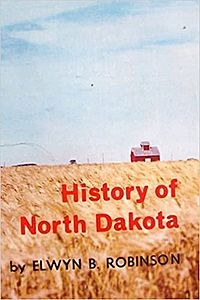History of North Dakota (book) facts for kids
 |
|
| Author | Elwyn B. Robinson |
|---|---|
| Illustrator | Jack Brodie |
| Country | United States |
| Language | English |
| Subject | North Dakota--History |
| Publisher | University of Nebraska Press |
|
Publication date
|
1966 |
| Media type | |
| Pages | 610 pp |
| ISBN | 0-911042-43-1 |
| OCLC | 33266680 |
| 978.4 | |
| LC Class | F636 .R6 1995 |
History of North Dakota is an important book about the past of the U.S. state of North Dakota. It was written by Elwyn B. Robinson. The book tells the story of North Dakota from thousands of years ago. It starts when Native Americans first lived there. The story continues all the way up to the 1900s.
The University of Nebraska Press published this book in 1966. It was the first detailed book to cover all of North Dakota's history. Many people still consider it the best book about the state's past. The first version of the book had 599 pages. It also included 32 pages of pictures and drawings by Jack Brodie.
Elwyn B. Robinson (1905–1985) was a history teacher. He taught at the University of North Dakota in Grand Forks. In 1958, he gave a famous speech. It was called "The Themes of North Dakota History." This speech was very popular. It eventually led to him writing the History of North Dakota book. The book later won an award. It received the Award of Merit from the American Association for State and Local History.
Key Ideas in North Dakota's History
In his important book, Elwyn B. Robinson pointed out six main ideas. He called these "themes" that run through North Dakota's history. These themes help us understand the state's past.
- Remoteness: This means North Dakota was often far away from big cities and major events.
- Dependence: The state often relied on other places or things. This could be for money or supplies.
- Radicalism: Sometimes, people in North Dakota supported big changes. They wanted new ideas for how things should work.
- Economic disadvantage: The state often faced money problems. It was sometimes harder for people there to make a living.
- The "too-much mistake": This idea suggests that people sometimes tried to do too much. They might have tried to grow too many crops or expand too quickly.
- Adjustment: Despite challenges, people in North Dakota learned to adapt. They found ways to live and thrive in their environment.

